Australia needs to ramp up policies and plans to fuel hydrogen trucks or will risk being lapped by the rest of the world in cutting emissions from heavy transport, a report has warned.
The CSIRO study, released on Monday, also warns Australia needs to develop hydrogen at central locations rather than individual service stations to keep prices low and should invest in specialised carbon fibre tankers to transport the new fuel.
The recommendations come just days after consultation closed on a review of Australia’s National Hydrogen Strategy and after a group of companies, including BP Australia and BOC, opened the first hydrogen refuelling facility at a service station in Brisbane.
The CSIRO study, called Hydrogen Refuelling Infrastructure: Priorities and Opportunities, compared Australia’s current approach to hydrogen with progress made in countries including Germany, Japan, South Korea, China and the US state of California.
Report co-author and GHD Advisory executive Shawn Wolfe said developments in those countries were significantly more advanced and could provide important insights into ways to decarbonise Australia’s heavy transport industry.
While battery electric vehicles provided a straightforward way to cut pollution from “light transport,” he said, other countries were moving quickly to use hydrogen-powered vehicles to reduce emissions from bigger vehicles covering longer distances.
“Hydrogen is seen to be the better solution for heavy road transport rather than electric because of the substantial weight of batteries required to power freight vehicles, buses and garbage trucks,” he said.
“Hydrogen also has a much quicker refuelling time than electric vehicles, which is important for things like long-haul freight.”
The report found producing hydrogen at central hubs and transporting it to refuelling stations was more cost-effective than producing it at service stations, and Australia would need to invest in specialised tankers to transport the fuel.
It also warned the industry should investigate public-private partnerships, revise government hydrogen policies and develop new standards for hydrogen refuelling equipment as there were not “equivalent standards in Australia” to match European guidelines.
While the technology was still under development, Mr Wolfe said Australian industry and governments should move quickly to develop new policies and plans or risk missing out on an important chance to cut transport pollution.
“The large vehicle manufacturing companies are clearly on a pathway to have all their vehicles zero-emission and for larger vehicles hydrogen is the answer so Australia needs to get into lock-step with that,” he said.
“If we come to the party too late, their focus will be on the markets that have already got refuelling infrastructure in place and already got orders in.”
Australia has fewer than 10 hydrogen refuelling stations, with the latest opening at BP’s Lytton service station on August 14, offering renewable hydrogen produced using solar power at Bulwer Island.
The federal government is currently reviewing the country’s National Hydrogen Strategy, released in 2019, with a view to becoming “a global hydrogen leader by 2030” in its use and export.
Jennifer Dudley-Nicholson
(Australian Associated Press)






